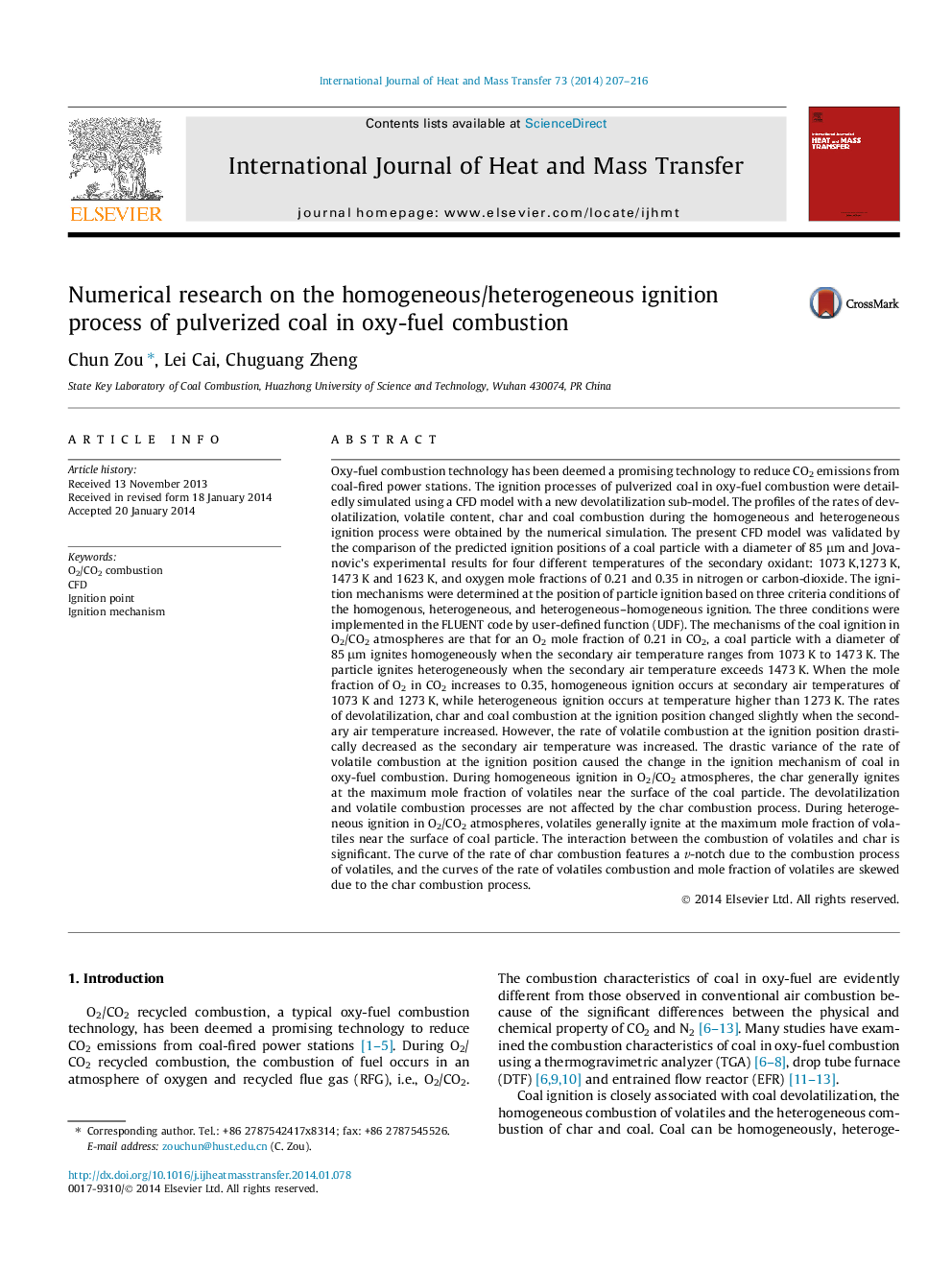| کد مقاله | کد نشریه | سال انتشار | مقاله انگلیسی | نسخه تمام متن |
|---|---|---|---|---|
| 657505 | 1458069 | 2014 | 10 صفحه PDF | دانلود رایگان |
عنوان انگلیسی مقاله ISI
Numerical research on the homogeneous/heterogeneous ignition process of pulverized coal in oxy-fuel combustion
ترجمه فارسی عنوان
تحقیقات عددی در فرآیند احتراق همگن / ناهمگن ذغال سنگ پودر در احتراق سوخت اکسید
دانلود مقاله + سفارش ترجمه
دانلود مقاله ISI انگلیسی
رایگان برای ایرانیان
کلمات کلیدی
موضوعات مرتبط
مهندسی و علوم پایه
مهندسی شیمی
جریان سیال و فرایندهای انتقال
چکیده انگلیسی
Oxy-fuel combustion technology has been deemed a promising technology to reduce CO2 emissions from coal-fired power stations. The ignition processes of pulverized coal in oxy-fuel combustion were detailedly simulated using a CFD model with a new devolatilization sub-model. The profiles of the rates of devolatilization, volatile content, char and coal combustion during the homogeneous and heterogeneous ignition process were obtained by the numerical simulation. The present CFD model was validated by the comparison of the predicted ignition positions of a coal particle with a diameter of 85 μm and Jovanovic's experimental results for four different temperatures of the secondary oxidant: 1073 K,1273 K, 1473 K and 1623 K, and oxygen mole fractions of 0.21 and 0.35 in nitrogen or carbon-dioxide. The ignition mechanisms were determined at the position of particle ignition based on three criteria conditions of the homogenous, heterogeneous, and heterogeneous-homogeneous ignition. The three conditions were implemented in the FLUENT code by user-defined function (UDF). The mechanisms of the coal ignition in O2/CO2 atmospheres are that for an O2 mole fraction of 0.21 in CO2, a coal particle with a diameter of 85 μm ignites homogeneously when the secondary air temperature ranges from 1073 K to 1473 K. The particle ignites heterogeneously when the secondary air temperature exceeds 1473 K. When the mole fraction of O2 in CO2 increases to 0.35, homogeneous ignition occurs at secondary air temperatures of 1073 K and 1273 K, while heterogeneous ignition occurs at temperature higher than 1273 K. The rates of devolatilization, char and coal combustion at the ignition position changed slightly when the secondary air temperature increased. However, the rate of volatile combustion at the ignition position drastically decreased as the secondary air temperature was increased. The drastic variance of the rate of volatile combustion at the ignition position caused the change in the ignition mechanism of coal in oxy-fuel combustion. During homogeneous ignition in O2/CO2 atmospheres, the char generally ignites at the maximum mole fraction of volatiles near the surface of the coal particle. The devolatilization and volatile combustion processes are not affected by the char combustion process. During heterogeneous ignition in O2/CO2 atmospheres, volatiles generally ignite at the maximum mole fraction of volatiles near the surface of coal particle. The interaction between the combustion of volatiles and char is significant. The curve of the rate of char combustion features a v-notch due to the combustion process of volatiles, and the curves of the rate of volatiles combustion and mole fraction of volatiles are skewed due to the char combustion process.
ناشر
Database: Elsevier - ScienceDirect (ساینس دایرکت)
Journal: International Journal of Heat and Mass Transfer - Volume 73, June 2014, Pages 207-216
Journal: International Journal of Heat and Mass Transfer - Volume 73, June 2014, Pages 207-216
نویسندگان
Chun Zou, Lei Cai, Chuguang Zheng,
